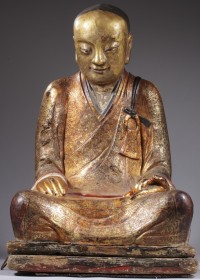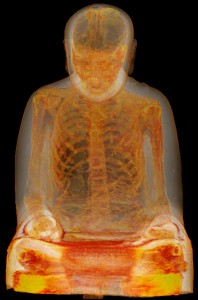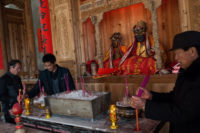 Two years ago, a 1,000-year-old statue of the Buddha made headlines when a striking CT scan exposed the mummified monk within. The statue was scanned at a hospital in Amsterdam when it was in the country to take part in the Mummies exhibition at the Drents Museum in Assen, the Netherlands. The exhibition proffered the Buddha statue as an example of the extreme practice of self-mummification, in which Buddhist monks spent years starving and poisoning themselves before having themselves walled into a constricted space to die. If three years later their bodies were found mummified, they were considered to have attained the rank of Buddha and their remains were venerated.
Two years ago, a 1,000-year-old statue of the Buddha made headlines when a striking CT scan exposed the mummified monk within. The statue was scanned at a hospital in Amsterdam when it was in the country to take part in the Mummies exhibition at the Drents Museum in Assen, the Netherlands. The exhibition proffered the Buddha statue as an example of the extreme practice of self-mummification, in which Buddhist monks spent years starving and poisoning themselves before having themselves walled into a constricted space to die. If three years later their bodies were found mummified, they were considered to have attained the rank of Buddha and their remains were venerated.
 According to the information on the exhibition’s website and labels, the monk sealed in the statue was believed to be Master Liuquan of the Chinese Meditation School, aka Zen Buddhism, who died around 1100 A.D. There was no evidence offered in support of this surprisingly specific identification, nor were there any details about who owned the statue. The press materials alluded to this being the first time the statue was allowed to leave China and that it was the only Chinese Buddhist mummy made available for scientific study in the West.
According to the information on the exhibition’s website and labels, the monk sealed in the statue was believed to be Master Liuquan of the Chinese Meditation School, aka Zen Buddhism, who died around 1100 A.D. There was no evidence offered in support of this surprisingly specific identification, nor were there any details about who owned the statue. The press materials alluded to this being the first time the statue was allowed to leave China and that it was the only Chinese Buddhist mummy made available for scientific study in the West.
Well, that may all be a big bunch of lies, or at least misinformation of the “Swiss private collection” variety to act as a smokescreen for some very shady dealings in stolen cultural heritage. A lawsuit currently in the Dutch courts presents an entirely different ownership history and identification of the statue and mummy. The plaintiff is the tea-farming mountain village of Yangchun in southeastern Chinese province of Fujian which claims the statue was stolen from a temple there in 1995. The defendant is a Dutch collector, who bought the statue and the human remains it contains in Hong Kong in 1996.
In March of 2015, one of the villagers saw a photograph of the statue on display at the Mummy World exhibition at Budapest’s Natural History Museum. He immediately recognized it as the Zhanggong Patriarch, a statue containing a mummified monk that he and his fellow villagers have venerated for centuries.
The lawyers will argue that according to Dutch law “a person is not allowed to have a known body in their possession,” Holthuis said.
“We also have enough evidence to prove that the statue is indeed the one that was stolen from the temple,” he added.
“The fact that it was sold a few months after it was stolen, that it contains certain texts referring to the name ‘Zhanggong’ and that its dating more or less corresponds to the period that the monk was alive,” were some of the arguments which will be presented, he said.
There are some pictures of it in the temple in 1989, and the village still has the clothes and crown the statue was wearing before the thieves stripped it. The picture alone isn’t as dispositive as you might think because of those clothes and crown. They obscure some of the identifying detail of the statue which has been displayed without its traditional accessories in the mummies exhibitions.
According to centuries of village tradition, the statue contains the remains of a monk named Zhang who moved to the village with his mother when he was a boy during the Song dynasty (960–1279). He went from cowherd to Buddhist monk to a gilded mummy worshipped by generations of residents. (There is no suggestion of self-mummification. He was mummified after his death as an indication of the great esteem in which he was held, an account that is consistent with the discovery that his organs had been removed and replaced with paper fill.) The villagers prayed to him at all major festivals and seasonal events. Each year the statue was transported through the village stopping at every house, and the monk’s birthday was celebrated every year with a grand festival. The village’s ancestral records seemingly confirm the oral history; they document the presence of the Patriarch as early as the Song Dynasty.
 The theft of the Zhanggong Patriarch was devastating to the villagers. Some of the older residents had risked their lives to protect him from the iconoclastic marauders of the Cultural Revolution. The statue was kept constantly on the move for its safety, hidden in pits and people’s homes, sometimes moved twice in a night. They put a replica in his place, a rather rough grey version of the elegant gilded original, and the villagers still pray to it.
The theft of the Zhanggong Patriarch was devastating to the villagers. Some of the older residents had risked their lives to protect him from the iconoclastic marauders of the Cultural Revolution. The statue was kept constantly on the move for its safety, hidden in pits and people’s homes, sometimes moved twice in a night. They put a replica in his place, a rather rough grey version of the elegant gilded original, and the villagers still pray to it.
There’s one big problem. Nobody knows where the statue is right now. Apparently the collector, Dutch architect Oscar van Overeem, traded it with somebody in 2015 and he’s not saying who. The timing of this swap is curious, especially in the light of van Overeem’s strenuous denial that his mummy was the Zhanggong Patriarch. He insisted that he had easily disproven the village’s claim to the Chinese representative who contacted him to negotiate repatriation, but worked out a deal anyway to donate the statue to an unnamed Buddhist temple near Yangchun. He had struck this bargain, he said in May of 2015, “because he believed it deserved to return to its homeland ‘to be incorporated in truly Buddhist surroundings’ and worshiped ‘by those who love and appreciate him.'”
So in May of 2015, the collector believed that the mummy deserved to be home among those who love and pray to him, but I guess that belief wasn’t all that strongly held because the statue and mummy are not in any Buddhist temple near Yangchun. It’s nowhere to be found. Whoever the third party is has little incentive to come forward, so even if the village wins in court — which would be a landmark decision for Chinese cultural patrimony repatriation because it would be the first time a heritage object is returned due to the courts rather than through diplomatic channels — it could still be left bereft of its beloved Zhanggong Patriarch.
I suppose that is the problem with worship, some want to do it for religion, in this case, and others for mere possession of an unusual object.
In this case, I’d call it a problem with possession rather than with worship. The worshippers were fine until the possessor came along.
I find it ironic that the statue survived communism only to be lost to capitalism. :facepalm:
It wasn’t lost to capitalism: somebody simply stole it.
Easy one:
In case the Dutch architect really traded the Buddha with somebody in 2015 and he is not saying who, why not turning him into a dried up patriarch ?
:yes:
Sad story
The Dutch police should gonthrouhh this collectors past and present collection in detail, and check all provenance. And publish to enable challlenge from owners.
I have stopped receiving the daily post to this list. Does anyone know how to get back on the list?
You have not lost your daily posts, I have them stored in my Swiss warehouse and can prove I have had them there since prior to 1972.
Seriously, do you mean we can get a daily post by email or on Facebook or something? Why did I not know this…